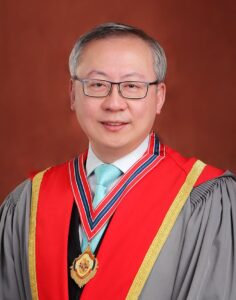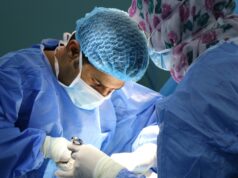
Born and raised in Singapore, interventional radiologist Tay Kiang Hiong is professor and head of the department of vascular and interventional radiology at Singapore General Hospital and and president-elect of the Asia-Pacific Society of Interventional Radiology (ASPCVIR). After completing his medical and diagnostic radiological training in Singapore, Kiang Hiong trained at the University of British Columbia in Vancouver, Canada under the mentorship of Lindsay Machan. Reflecting on his training and career in conversation with Interventional News, Kiang Hiong talks about the past, the present and the future of interventional radiology (IR) in the Asia-Pacific region, imparting advice for trainees starting out.
IN: How was it starting a career in IR in Singapore?
Starting a career in IR in Singapore has been both exhilarating and challenging. Exhilarating because I started in the 1990s and 2000s where IR was experiencing rapid evolution and growth in Singapore. We had new devices or techniques emerge every few months and it was very gratifying to see IR procedures replacing traditional surgical treatments as the new standard of care. In many patients with dire conditions who are unfit for surgery, IR often is the last bastion that can save their lives. To this day, I feel very privileged to be an interventional radiologist.
However, it was also challenging as we are short of manpower. Especially in the early days, where the work hours were long, it was extremely hard to balance work and spending time with the family, not to mention research and teaching commitments limiting this quality time as well. As IR gained success, it attracted other specialists, leading to exhausting “turf wars”. Additionally, IR’s lack of public and physician awareness has limited referrals, though this is gradually improving through public campaigns and medical school education on IR.
IN: What are the key differences in IR practice between the Asia Pacific region and Europe?
It is not surprising that the IR practice is different in Asia Pacific and Europe due to differences and variations in healthcare infrastructure, patient demographics and disease prevalence, economic status and regulatory frameworks.
Healthcare infrastructure in the Asia-Pacific region varies greatly, from advanced systems (e.g. Japan, Singapore, South Korea, Australia) to developing countries with no access to advanced medical technologies. As a result, IR services and technologies differ significantly, with some countries having no IR presence. In less developed economies, IR is limited to basic procedures like biopsies and drainages due to cost constraints, while well-developed countries offer a full range of IR procedures, often reimbursable. Interventional oncology (IO) is common due to high rates of hepatocellular carcinoma (HCC), but endovascular interventions for peripheral vascular and aortic diseases are diminishing and limited to a few centres of excellence in our region as they are mostly handled by cardiologists or vascular surgeons currently.
With respect to IR training, the Asia Pacific region has fewer formalised and standardised IR training programmes. Some countries have established formal IR fellowships and specialised training pathways, but in many parts of our region, training is much less structured, with trainees often having to go abroad for fellowship training, often times in Europe or North America. In the future, the ASPCVIR aspire to implement a vehicle for IR training much like the European Board of Interventional Radiology (EBIR) certification, to standardise IR training and certification in our region.
IN: As president-elect of APSCVIR, what do you hope to achieve in your term?
I have been involved with the APSCVIR for many years. Before 2016, I sat in the executive committee for several years. After 2016, I was the secretary general for three terms under the newly registered society, and now I am the president elect. I have been in a very privileged position for many years now, with the ability to influence and shape some of the strategic directions for APSCVIR.
We formerly registered the society in 2016 because we wanted to do more than just organising a scientific meeting. IR education has always been the main focus of APSCVIR and we do this through our annual scientific meeting and outreach programme.
The outreach programme is a signature programme of our society. Led by Bien Soo Tan (Singapore General Hospital, Singapore) it is comprised of onsite lectures, workshops and live case demonstrations supplemented by webinars every two to three months. The faculty of the outreach programme are all volunteers who fund their own travel to do so, and faculty from the Cardiovascular and Interventional Radiological Society of Europe (CIRSE) and the Society of Interventional Radiology (SIR) are regularly invited to help out in these programmes. We are poised to expand this initiative to more countries.
The Japanese Society of Interventional Radiology (JSIR) recently offered their online journal InterVentional Radiology (IVR) to be the official journal of JSIR and APSCVIR. This opens up another avenue for IR education and research for our members which I hope to actively promote in the coming years.
Strengthening international collaboration with other IR organisations around the world, especially SIR and CIRSE remains our top priority. Other than knowledge and skills exchange at our respective annual meetings, we hope to collaborate in other areas like journal publishing, IR certification exams, advocacy for IR, online education platforms etc. Through these efforts, my colleagues and I in the executive board of APSCVIR hope to leave a lasting impact on the growth, accessibility, and quality of IR across the Asia-Pacific region.
IN: What advice can you give to interventional radiologists starting out in the Asia-Pacific region?
Starting out as an interventional radiologist in the Asia-Pacific region offers both exciting opportunities and unique challenges. The region’s diversity in healthcare systems, patient populations, and access to technology means that your path might vary depending on where you’re based. I have the following tips for new interventional radiologists in this dynamic environment:
- Build a strong foundation in diagnostic radiology
A strong grasp of diagnostic radiology is essential for becoming an excellent interventional radiologist. Proficiency in imaging interpretation ensures precise planning and execution, while knowledge of cross-sectional anatomy is key for guiding complex interventions like tumour ablation and embolization.
- Prioritise hands-on training
Hands-on experience across various IR subspecialties is crucial for working in diverse clinical settings. Pursue a formal IR fellowship at a reputable centre in Asia Pacific, Europe, or North America if possible. Also, attend workshops, conferences, and hands-on courses from organisations like APSCVIR, SIR, or CIRSE to refine your skills.
- Adapt to local healthcare realities
IR resources vary greatly across the Asia-Pacific, and you may often work in resource-limited environments. Adapting to local healthcare infrastructure is key to success. Get involved in expanding IR services by demonstrating flexibility, leadership, and advocating its value to administrators and colleagues.
- Stay current with technological advances
IR is closely linked to advances in imaging and device technology. Stay updated on innovations like robotic interventions, angio-computed tomography (CT), cone-beam CT, and new embolisation or ablation devices. Despite regional limitations, global resources such as online platforms, journals, and webinars can keep you informed about the latest techniques.
- Focus on research and evidence-based practice
Research is critical to advancing the field of IR, and there is great potential for original research in the Asia-Pacific region, where unique patient demographics and disease profiles can yield valuable insights. Consider engaging in clinical trials or retrospective studies to contribute to the evidence base in IR.
- Prioritise on patient-centred care
Many patients in the Asia-Pacific region may be unfamiliar with IR. Spend time educating patients about how IR can help them, the risks involved, and what to expect during recovery. Emphasise the importance of follow-up to ensure long-term success of procedures. Clear communication builds trust and improves patient outcomes.
- Advocate for policy and reimbursement changes
In some Asia-Pacific countries, reimbursement for IR procedures is limited, and policies may not always reflect the cost-effectiveness of IR. Advocate for improved reimbursement models and integration of IR into national healthcare systems, emphasising the potential to reduce hospital stays, complications, and long-term costs.
- Stay resilient and be ready for challenges
IR is evolving rapidly, requiring adaptability to new technologies, healthcare changes, and patient needs. Success in the Asia-Pacific region demands determination, adaptability, and continuous learning, with a focus on foundational skills, collaboration, and engagement with professional societies. By doing so you can make a lasting impact in your career and contribute to the growth of IR across the region.










